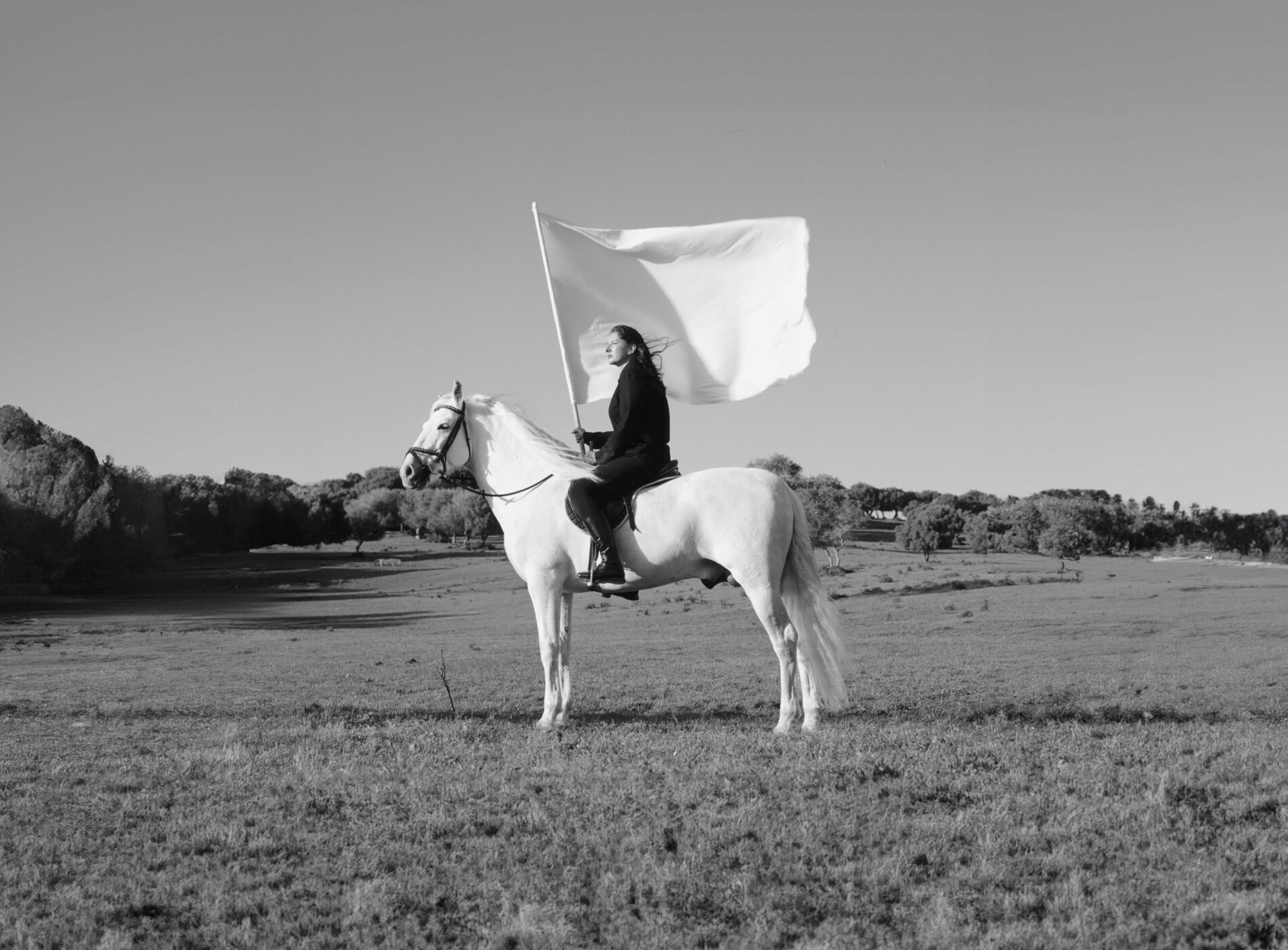

Hagop Keshishian, city plan of Anjar, 1939, courtesy of Anjar Municipality. © Vartivar Jaklian, Hossep Baboyan.
The permanence of home has been in flux throughout history. There are no shortages of examples of rebuilding; the ancient city of Troy existed in nine iterations, constantly being reconstructed on the bones of its predecessor; San Francisco and Tokyo each rebounded following catastrophic earthquakes and fires in 1906 and 1923, respectively; Warsaw earned the moniker “Phoenix City,” after its complete restoration following devastating World War II bombings and uprisings that left 85% of the city in ruins. Rather than building on top of what once was, imagine if your entire town packed up and started anew somewhere else. Is it really still home when everything familiar is gone?
Surviving the Armenian Genocide is a feat of survival and resilience in itself, but for the former residents of Musa Dagh, that was just one chapter of an astounding tale of rebirth and rebuilding. After escaping the Ottoman Empire in 1915, a group of diasporic Armenians planted new roots in Musa Dagh, a town split into six villages with an enviable view of mountains and sea in present-day Turkey—a town known for its abundance of fruit trees, music, and dancing. The demise of the Empire did not signal the end of the struggle for the refugees, though. In spite of the Treaty of Lausanne, which relegated the area as Syrian territory under the control of the French, the Turks began to retake the province a mere 20 years after the Armenians found refuge in Musa Dagh.


© Vartivar Jaklian, Hossep Baboyan.
In the late 1930s, with support from the French colonial government, the town’s residents picked up their lives and settled in Anjar, a tiny town teetering on the Syria-Lebanon border, just 37 miles east of Beirut. The _Musa Daghtsis_, far from the fruitful lands of Turkey, found themselves reconfiguring their lives in a desert, forced to rebuild for the second time in recent memory. Though Musa Dagh was behind them, the refugees incorporated their beloved town into the foundation of their new home, separating it into six segments to honor the six villages they came from. This time, they were siphoned off by cross streets rather than ravines and trees. A mainstay of Armenian culture in a land that is a nearly 23-hour-drive from Yerevan (the capital of Armenia), Anjar was established on the principles of emergency housing, establishment of the religious communities, and agriculture.
It has now been 80 years since the _Musa Daghtsis_ arose from the ashes of their old life—a feat that was continually tested, particularly during World War II and the Lebanese Civil War in the 1980s. Architect and photographer Vartivar Jaklian and architect and filmmaker Hossep Baboyan—both Lebanese with Armenian roots—examine the archival photos of Anjar in its early days and contrast it with the town as it stands today in their new book, _Anjar 1939-2019: Rebuilding Musa Dagh in Lebanon_, out mid-March via publisher Hajte Cantz.
The refugees held out hope for return to Musa Dagh, before eventually resigning themselves to the permanence of their new home. However, as Susan Paul Pattie, author of _The Armenian Legionaries: Sacrifice and Betrayal in World War I_, notes in the book’s forward, the first citizens of Anjar were “people of action.” Certainly emblematic of the experience of survival against all odds, Paul Pattie cites the planting of a single apple tree in the harsh Lebanese desert, which eventually grew into an orchard that helps sustain Anjar’s economic backbone to this day.


© Vartivar Jaklian, Hossep Baboyan.
As Jaklian recognizes in the introduction, documenting Anjar 80 years after its settlement by refugees of the Armenian Genocide is not only important for the sake of cultural and historical preservation, but also to serve as a reminder of how refugees are perceived during an increasingly volatile era rife with immigration debate. “The human being behind is often seen as a delinquent or a problem at best, something which today’s politicians use as a terror campaign in their political agenda and everyday discourse,” he writes.
In a time in which migration is increasingly depersonalized and politicized, Jaklian and Baboyan are able to point to Anjar—a town that exemplifies the resilience of refugees—a flourishing orchard that grew out of a desert.
 
Hagop Keshishian, city plan of Anjar, 1939, courtesy of Anjar Municipality. © Vartivar Jaklian, Hossep Baboyan.
The permanence of home has been in flux throughout history. There are no shortages of examples of rebuilding; the ancient city of Troy existed in nine iterations, constantly being reconstructed on the bones of its predecessor; San Francisco and Tokyo each rebounded following catastrophic earthquakes and fires in 1906 and 1923, respectively; Warsaw earned the moniker “Phoenix City,” after its complete restoration following devastating World War II bombings and uprisings that left 85% of the city in ruins. Rather than building on top of what once was, imagine if your entire town packed up and started anew somewhere else. Is it really still home when everything familiar is gone?
Surviving the Armenian Genocide is a feat of survival and resilience in itself, but for the former residents of Musa Dagh, that was just one chapter of an astounding tale of rebirth and rebuilding. After escaping the Ottoman Empire in 1915, a group of diasporic Armenians planted new roots in Musa Dagh, a town split into six villages with an enviable view of mountains and sea in present-day Turkey—a town known for its abundance of fruit trees, music, and dancing. The demise of the Empire did not signal the end of the struggle for the refugees, though. In spite of the Treaty of Lausanne, which relegated the area as Syrian territory under the control of the French, the Turks began to retake the province a mere 20 years after the Armenians found refuge in Musa Dagh.

Hagop Keshishian, city plan of Anjar, 1939, courtesy of Anjar Municipality. © Vartivar Jaklian, Hossep Baboyan.
The permanence of home has been in flux throughout history. There are no shortages of examples of rebuilding; the ancient city of Troy existed in nine iterations, constantly being reconstructed on the bones of its predecessor; San Francisco and Tokyo each rebounded following catastrophic earthquakes and fires in 1906 and 1923, respectively; Warsaw earned the moniker “Phoenix City,” after its complete restoration following devastating World War II bombings and uprisings that left 85% of the city in ruins. Rather than building on top of what once was, imagine if your entire town packed up and started anew somewhere else. Is it really still home when everything familiar is gone?
Surviving the Armenian Genocide is a feat of survival and resilience in itself, but for the former residents of Musa Dagh, that was just one chapter of an astounding tale of rebirth and rebuilding. After escaping the Ottoman Empire in 1915, a group of diasporic Armenians planted new roots in Musa Dagh, a town split into six villages with an enviable view of mountains and sea in present-day Turkey—a town known for its abundance of fruit trees, music, and dancing. The demise of the Empire did not signal the end of the struggle for the refugees, though. In spite of the Treaty of Lausanne, which relegated the area as Syrian territory under the control of the French, the Turks began to retake the province a mere 20 years after the Armenians found refuge in Musa Dagh.
 
© Vartivar Jaklian, Hossep Baboyan.
In the late 1930s, with support from the French colonial government, the town’s residents picked up their lives and settled in Anjar, a tiny town teetering on the Syria-Lebanon border, just 37 miles east of Beirut. The _Musa Daghtsis_, far from the fruitful lands of Turkey, found themselves reconfiguring their lives in a desert, forced to rebuild for the second time in recent memory. Though Musa Dagh was behind them, the refugees incorporated their beloved town into the foundation of their new home, separating it into six segments to honor the six villages they came from. This time, they were siphoned off by cross streets rather than ravines and trees. A mainstay of Armenian culture in a land that is a nearly 23-hour-drive from Yerevan (the capital of Armenia), Anjar was established on the principles of emergency housing, establishment of the religious communities, and agriculture.
It has now been 80 years since the _Musa Daghtsis_ arose from the ashes of their old life—a feat that was continually tested, particularly during World War II and the Lebanese Civil War in the 1980s. Architect and photographer Vartivar Jaklian and architect and filmmaker Hossep Baboyan—both Lebanese with Armenian roots—examine the archival photos of Anjar in its early days and contrast it with the town as it stands today in their new book, _Anjar 1939-2019: Rebuilding Musa Dagh in Lebanon_, out mid-March via publisher Hajte Cantz.
The refugees held out hope for return to Musa Dagh, before eventually resigning themselves to the permanence of their new home. However, as Susan Paul Pattie, author of _The Armenian Legionaries: Sacrifice and Betrayal in World War I_, notes in the book’s forward, the first citizens of Anjar were “people of action.” Certainly emblematic of the experience of survival against all odds, Paul Pattie cites the planting of a single apple tree in the harsh Lebanese desert, which eventually grew into an orchard that helps sustain Anjar’s economic backbone to this day.

© Vartivar Jaklian, Hossep Baboyan.
In the late 1930s, with support from the French colonial government, the town’s residents picked up their lives and settled in Anjar, a tiny town teetering on the Syria-Lebanon border, just 37 miles east of Beirut. The _Musa Daghtsis_, far from the fruitful lands of Turkey, found themselves reconfiguring their lives in a desert, forced to rebuild for the second time in recent memory. Though Musa Dagh was behind them, the refugees incorporated their beloved town into the foundation of their new home, separating it into six segments to honor the six villages they came from. This time, they were siphoned off by cross streets rather than ravines and trees. A mainstay of Armenian culture in a land that is a nearly 23-hour-drive from Yerevan (the capital of Armenia), Anjar was established on the principles of emergency housing, establishment of the religious communities, and agriculture.
It has now been 80 years since the _Musa Daghtsis_ arose from the ashes of their old life—a feat that was continually tested, particularly during World War II and the Lebanese Civil War in the 1980s. Architect and photographer Vartivar Jaklian and architect and filmmaker Hossep Baboyan—both Lebanese with Armenian roots—examine the archival photos of Anjar in its early days and contrast it with the town as it stands today in their new book, _Anjar 1939-2019: Rebuilding Musa Dagh in Lebanon_, out mid-March via publisher Hajte Cantz.
The refugees held out hope for return to Musa Dagh, before eventually resigning themselves to the permanence of their new home. However, as Susan Paul Pattie, author of _The Armenian Legionaries: Sacrifice and Betrayal in World War I_, notes in the book’s forward, the first citizens of Anjar were “people of action.” Certainly emblematic of the experience of survival against all odds, Paul Pattie cites the planting of a single apple tree in the harsh Lebanese desert, which eventually grew into an orchard that helps sustain Anjar’s economic backbone to this day.
 
© Vartivar Jaklian, Hossep Baboyan.
As Jaklian recognizes in the introduction, documenting Anjar 80 years after its settlement by refugees of the Armenian Genocide is not only important for the sake of cultural and historical preservation, but also to serve as a reminder of how refugees are perceived during an increasingly volatile era rife with immigration debate. “The human being behind is often seen as a delinquent or a problem at best, something which today’s politicians use as a terror campaign in their political agenda and everyday discourse,” he writes.
In a time in which migration is increasingly depersonalized and politicized, Jaklian and Baboyan are able to point to Anjar—a town that exemplifies the resilience of refugees—a flourishing orchard that grew out of a desert.

© Vartivar Jaklian, Hossep Baboyan.
As Jaklian recognizes in the introduction, documenting Anjar 80 years after its settlement by refugees of the Armenian Genocide is not only important for the sake of cultural and historical preservation, but also to serve as a reminder of how refugees are perceived during an increasingly volatile era rife with immigration debate. “The human being behind is often seen as a delinquent or a problem at best, something which today’s politicians use as a terror campaign in their political agenda and everyday discourse,” he writes.
In a time in which migration is increasingly depersonalized and politicized, Jaklian and Baboyan are able to point to Anjar—a town that exemplifies the resilience of refugees—a flourishing orchard that grew out of a desert.









.JPG)
.jpg)







